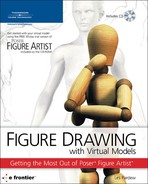Creating the Manikin
The next step in drawing figures is to create a simplified manikin of the body. The manikin is like the simplified skeleton in that it uses only minimal detail, but unlike the skeleton that works mostly with inner structure of the body, the manikin deals more with surface detail. Drawing simplified skeletons and gesture drawings is fine, but at some point you will want to add some flesh and muscle to your drawings.
Figure 2.22 shows a male manikin. You can use this for an example of how to draw your manikin.
Figure 2.22. The manikin adds surface detail to the beginning stages of the figure drawing.

The manikin does not need to be very detailed to work well; it just needs to show the bulk and dimension of the figure. You can simplify your manikin beyond what I have done here if it will make it easier to draw.
You will notice that in my manikin, a lot of detail such as fingers, toes, and facial features are omitted. This is because the purpose of the manikin is to establish the figure on the paper, not to deal with detail. The detail will come later. Artists use the manikin as a simplified figure for working out compositions and for quickly sketching their ideas and inspiration.
When you draw the manikin, simplify the muscle groups. Think of them as lying over or around the bones of the skeleton. In Chapter 3, “Figure Anatomy,” we will cover human anatomy in more detail, but for now just do the best you can with what you already know.
The human body is made for movement. The muscles are placed so that they can contract and move various limbs or other body parts. The muscles at the top of the shoulders are called deltoids. They pull the arm up. The muscles across the chest are the pectoral muscles, and they pull the arms forward. The large muscles of the back are called the latissimus dorsi muscles, or lats for short. They are used to pull the arms back. These are just three of the many muscles used to move the arm.
If you do any weightlifting, you know that lifting weight above your head will work your deltoid muscles and make those muscles more pronounced. The bench press will work the pectoral muscles, and rowing will work the lats. Sometimes it is a good practice for the artist to go to the gym and work the different muscle groups to see how they affect movement. You will know which muscles you worked because they will be the ones that ache the next morning.
Figure 2.23 shows the female manikin. If you compare her to the male version, you can readily see that she is very different than the male.
Figure 2.23. The female manikin is different than the male manikin.

Although male and female bodies have many similarities, they are also very different. A single manikin will not work well for drawing both figures. You should develop your own manikins for both the male and female figures. Some of the main differences between the two manikins are in the pelvis. On the female, the hip bones are higher, wider, and deeper than on the male. The female waistline is higher than the male’s. The female ribcage is smaller and the shoulders are narrower. The female’s arms are generally more slender than the male’s, but her upper thigh area is often thicker. Her legs tend to have more of an overall taper from the hip to the ankle. Her hands and feet are often smaller than those on the male manikin. As you become more familiar with the male and female figures, you will notice other differences.
